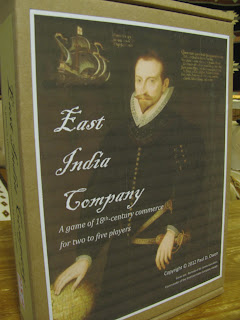Ridere, ludere, hoc est vivere.
Wednesday, November 14, 2012
Trade triangles in "East India Company"
Monday, November 12, 2012
Tsuro, Settlers, and Time Travellers
Tsuro
One of my posts last Thursday described my initial impression of Tsuro of the Seas, a recent variation on the Calliope Games gem Tsuro (designer Tom McMurchie; artists Shane Small, Cathy Brigg, and Sarah Phelps; publisher Calliope Games). Playing TotS made me want to revisit the original Tsuro, which my good friend Grant Greffey had given us for Christmas a couple of years ago. As it happened, we had in turn recently given a copy to our friend Jeff, so on the occasion of having a number of friends over for dinner and games, he was happy to break it out and give it a spin.
 |
| (c) Calliope Games. Used by permission |
Thursday, November 8, 2012
Running the numbers in East India Company
I've mentioned several times that I'm worried about game length in "East India Company." Each turn has a "New Colony Phase" in which a tile is drawn from a bag and added to one of the seven colonies on the board. There are 21 tiles, three for each colony. My previous rules held that the tile draw would trigger game end when all seven colonies had at least two tiles. But the Congress of Gamers playtest ran the maximum possible length, when the second China tile didn't come out until all 18 tiles on the other six colonies had been drawn. That turned out to be too long.
After-school special: East India and Tsuro of the Seas
My friends Frank Hodge, Keith Ferguson, and Mike R. and I got together this evening for a couple of games at Game Parlor in Chantilly, Virginia, after work today.
East India Company
The guys were gracious enough to agree to another playtest of "East India Company." It was Mike's first time with it, but Keith and Frank had each played at least once. As I mentioned in my previous post, I increased the ship speeds, allowed for ship upgrades as an alternative to building ships, and added a new game-end trigger condition. The first two measures were intended to improve the cost-effectiveness of investing in ships, and the third was intended to shorten overall game length.
East India Company
The guys were gracious enough to agree to another playtest of "East India Company." It was Mike's first time with it, but Keith and Frank had each played at least once. As I mentioned in my previous post, I increased the ship speeds, allowed for ship upgrades as an alternative to building ships, and added a new game-end trigger condition. The first two measures were intended to improve the cost-effectiveness of investing in ships, and the third was intended to shorten overall game length.
Wednesday, November 7, 2012
Playtesting preparations
Tomorrow after work I plan to bring my prototype of "East India Company" to Game Parlor in Chantilly, Virginia, for a playtest session with some of my gaming buddies. One problem I had with this prototype at the UnPub ProtoZone event at Congress of Gamers last month was that the labels I had made for the ships didn't stick well to the spray-painted basswood ship pieces that I'd made. So I spent this evening re-gluing all the labels with Elmer's white glue. I'll leave them to dry overnight in the hope that they won't start peeling off again tomorrow afternoon.
Sunday, November 4, 2012
Reading all the rules
I can't count the number of times I've gotten rules wrong in learning boardgames. It seems as though every time I learn a game for the first time, I get something wrong. Even worse, I am often the person in the group charged with reading the rules and then explaining the game to the other player(s), so I propagate my misunderstanding to other innocent souls.
Friday, November 2, 2012
Close Camels in Samarkand
Cocktail hour came with camels, pretzel chips, and hummus as we broke out Samarkand: Routes to Riches (designers David V.H. Peters and Harry Wu, artist Jo Hartwig, publisher Queen Games). I really like this game of Middle East merchant families and camel caravans. Both Kathy and I have come to appreciate the scoring focus on expanding trading routes to products whose cards we hold and especially on forming trade relationships between families in which we have an interest.
Tuesday, October 30, 2012
Lessons Learned in Le Havre
For today's cocktail hour game, Kathy and I selected one that we both like but are still getting the hang of, the worker-placement masterpiece Le Havre (designer Uwe Rosenberg, artists Klemens Franz and Uwe Rosenberg, publisher Lookout Games [website in German]). We've played three times before; Kathy won the first two, and I managed to win the last one. This time we fell into a familiar pattern - Kathy kept beating me to the punch, with the knockout blow being a big shipment of leather and bread for 26 Francs. I had some high-point buildings, plus both an iron ship and a steel ship, but it wasn't enough to overcome Kathy's strong position (including the 22-point steel mill), so she won 117 to 96.
Subscribe to:
Comments (Atom)
